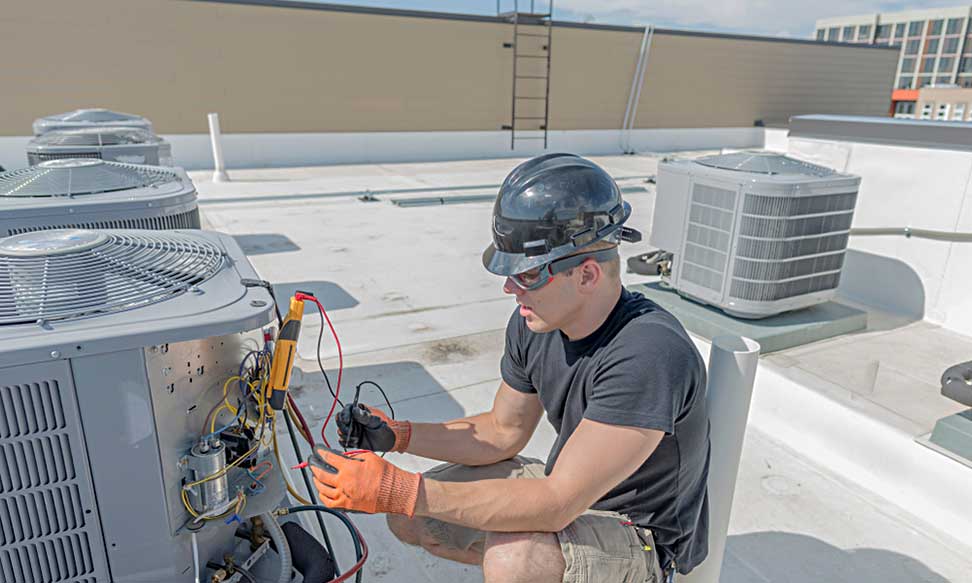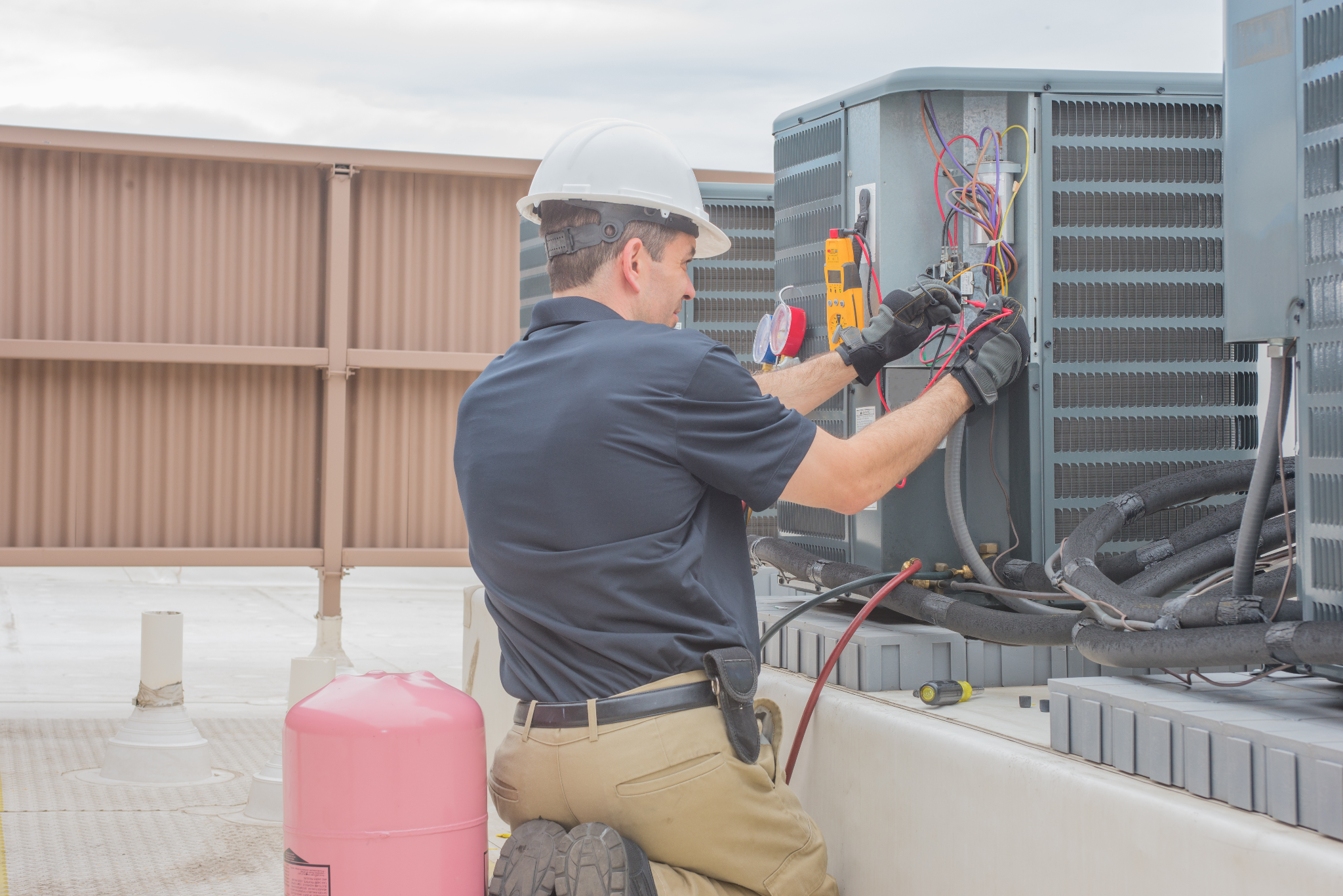Just How a Heat Pump and Furnace Work Together to Enhance Your Home's Heating Efficiency
Recognizing exactly how a warmth pump and furnace job together is important for homeowners seeking efficient heating remedies. Each system has its toughness, giving a balanced approach to home comfort. The warm pump masters modest temperatures, while the heating system delivers rapid heat throughout extreme cold. This harmony not just minimizes energy costs but additionally enhances the life expectancy of both appliances. What elements influence this cooperation, and how can homeowners maximize their advantages?
Recognizing Warm Pumps: Just How They Work
Although many people may be strange with their internal workings, heatpump play a crucial duty in contemporary heater. These tools operate by transferring warm from one area to one more, utilizing the concepts of thermodynamics. In chillier months, a warmth pump essences heat from the outside air, ground, or water, and transfers it inside to warm the home. On the other hand, during warmer months, it can turn around the procedure, acting as an a/c unit by getting rid of heat from inside to the outside.Heat pumps are composed of an evaporator, compressor, development, and condenser valve. The cooling agent within the system takes in warmth as it vaporizes at low temperatures and pressures. The compressor then raises the pressure and temperature level of the refrigerant, enabling it to release warmth as it condenses. This effective process can significantly decrease energy usage compared to standard heating techniques, making warm pumps a sustainable choice for environment control in homes.
The Duty of Furnaces in Home Home Heating
Heating systems play a crucial function in home heating by supplying a reputable source of heat during the colder months. They operate by creating warmth through burning or electrical resistance, dispersing it throughout the home via air ducts or radiant systems. The efficiency of a heater is often gauged by its Yearly Gas Application Performance (AFUE) score, which suggests exactly how efficiently the system converts fuel into heat.Furnaces can utilize various power sources, consisting of gas, oil, lp, or electrical power, enabling home owners to select one of the most suitable alternative for their demands. Unlike heat pumps, which might have a hard time in severe cool, heaters preserve regular performance, guaranteeing that interior temperatures continue to be comfy no matter exterior conditions. Furthermore, contemporary furnaces usually come outfitted with innovative modern technology, such as smart thermostats and variable-speed blowers, enhancing their effectiveness and responsiveness. This flexibility makes heaters a vital component in all-encompassing home heating methods.

Benefits of Making Use Of Both Systems With Each Other
Incorporating the strengths of both heaters and warmth pumps can lead to an extra effective and reliable home heating solution. Using both systems enables homeowners to capitalize on the heatpump's energy efficiency during milder temperatures while counting on the heater for more severe cold conditions. This dual strategy can substantially reduce power expenses, as warm pumps take in less electricity than conventional home heating techniques when temperature levels are moderate.Additionally, utilizing both systems with each other can boost comfort levels in the home. Heatpump can supply constant, even home heating, while heating systems can quickly raise ambient temperatures when needed. The assimilation of both systems can prolong the life expectancy of devices by reducing wear and tear on each device, as they share the work. Inevitably, home owners can appreciate a balanced, affordable heating remedy that changes perfectly to varying weather, guaranteeing a warm and inviting home throughout the wintertime months.
How Warmth Pumps and Furnaces Complement Each Other
When home owners incorporate heatpump and heating systems, they produce a complementary heating unit that optimizes performance and comfort. Heatpump operate by transferring warmth from the outdoors air or ground, making them extremely efficient in modest environments. They succeed throughout milder temperature levels, giving affordable heating. Alternatively, furnaces generate warm with burning or electric resistance, delivering solid, prompt heat during extreme cold conditions.The mix of these 2 systems enables for vibrant modifications based upon temperature level changes. Throughout warmer months or milder wintertime days, the warmth pump can take the lead, preserving energy and decreasing prices. As temperature levels decline, the heater can seamlessly engage, guaranteeing constant heat throughout the home. This harmony not only optimizes power use yet likewise improves the life-span of both systems, as each system operates within its optimal performance variety. Together, they produce a balanced environment that adjusts to varying environment needs.
Optimizing Performance: Tips for Homeowners
Home owners can enhance their heating effectiveness through several practical approaches. Establishing a regular maintenance schedule, integrating smart thermostat modern technology, and executing efficient insulation and sealing options are essential actions. These steps not just improve comfort yet also minimize power prices.
Routine Upkeep Arrange
To ensure optimal home heating efficiency, establishing a normal upkeep timetable is necessary for any type of home. Home owners must prioritize regular inspections of both heatpump and heating systems to establish peak performance. This consists of altering air filters each to 3 months, as clogged up filters can greatly decrease efficiency. In addition, organizing professional maintenance a minimum of yearly enables specialists to recognize and address possible problems prior to they intensify. Home owners should also clean the heatpump's outdoor device to protect against particles build-up that can prevent air flow. By sticking to a routine upkeep timetable, homeowners not only improve their heater' effectiveness yet additionally expand their lifespan, resulting in higher comfort and decreased energy costs throughout the colder months.
Smart Thermostat Integration
Integrating a smart thermostat into a home heating system can significantly enhance power performance, specifically as it enables for exact control over temperature settings. These tools can discover the house owner's schedule and preferences, instantly changing the temperature to optimize convenience while decreasing power use. They can decrease home heating during times when the home is empty, lowering unneeded consumption. Many clever thermostats also provide real-time power usage data, allowing house owners to make educated decisions regarding their home heating practices. Additionally, remote gain access to through smart device apps enables users to change setups from anywhere, making sure the home is warm upon return. Generally, smart thermostat combination not just improves convenience but significantly contributes to energy financial savings and efficiency.
Insulation and Sealing Solutions
Smart thermostats play an important role in energy effectiveness, yet their efficiency can be substantially enhanced by appropriate insulation and securing services. Home owners should prioritize shielding attics, floorings, and wall surfaces to reduce warm loss. High-grade insulation materials, such as spray foam or fiberglass, can significantly enhance thermal resistance. In addition, securing gaps around home windows, air ducts, and doors prevents chilly click this link air seepage and warm escape. Weatherstripping and caulking are efficient methods for resolving these leakages - furnace replacement. Regular evaluations for air leakages, in addition to using blower door tests, can assist identify trouble locations. By purchasing insulation and sealing, property owners can optimize the efficiency of their heater, inevitably causing reduced power consumption and reduced utility bills
Usual Misconceptions About Warmth Pumps and Furnaces
What misunderstandings border heatpump and furnaces? Lots of individuals mistakenly think that heatpump are inadequate in colder climates. Actually, modern-day warm pumps are made to run efficiently also in reduced temperatures, offering trusted heating throughout winter. Another typical myth is that heating systems are constantly much more efficient than heat pumps. This depends on the particular energy sources and performance scores of the systems in inquiry. Some may additionally assume that utilizing both systems at the same time is unneeded, yet as a matter of fact, this combination can maximize heating effectiveness, particularly throughout severe climate condition. Additionally, individuals usually think that heatpump call for consistent upkeep, when actually, they have comparable maintenance requires to conventional heater. By exposing these misconceptions, home owners can make more enlightened choices concerning their home heating choices, inevitably bring about improved convenience and power performance in their homes.
Upkeep Factors To Consider for Combined Equipments

Often Asked Inquiries
Can Heat Pumps Work Effectively in Very Cold Climates?
Warmth pumps can struggle in exceptionally chilly environments due to minimized performance and heat removal limitations. However, improvements in modern technology have brought about models developed for much better efficiency in such problems, enhancing their feasibility in rough environments.
For How Long Do Warmth Pumps and Furnaces Generally Last?
Heatpump typically last 15 to 20 years, while furnaces have a lifespan of 15 to thirty years. Routine upkeep can expand their long life, ensuring efficient operation and lowering the requirement for premature replacements.

What Is the Average Price of Setting Up Both Solutions?
The typical cost of setting up both a heatpump and a heating system normally ranges in between $5,000 to you could try here $10,000 - heat pump replacement ooltewah tn. Elements affecting this cost consist of system size, installment complexity, and regional labor prices
Are There Tax Obligation Incentives for Utilizing Energy-Efficient Home Heating Systems?
Lots of property owners make inquiries about tax motivations for energy-efficient home heating systems. Numerous government and state programs typically supply discounts or credit scores, motivating the fostering of lasting modern technologies to lower energy usage and advertise ecological my explanation duty.
How Do I Select the Right Dimension Warmth Pump and Furnace?
Selecting the ideal dimension heatpump and heater entails calculating the home's square footage, thinking about insulation top quality, and reviewing local climate. Consulting a professional can ensure suitable system efficiency and energy effectiveness based upon certain demands. heat pump installation ooltewah tn. Recognizing how a heat pump and furnace work together is important for property owners looking for effective heating solutions. In cooler months, a warmth pump removes heat from the outside air, ground, or water, and transfers it indoors to warm up the living room. When house owners incorporate warm pumps and furnaces, they develop a corresponding home heating system that makes best use of performance and convenience. Heat pumps operate by moving warm from the outside air or ground, making them very reliable in moderate climates. Warmth pumps can have a hard time in extremely cool environments due to minimized efficiency and heat removal restrictions